-
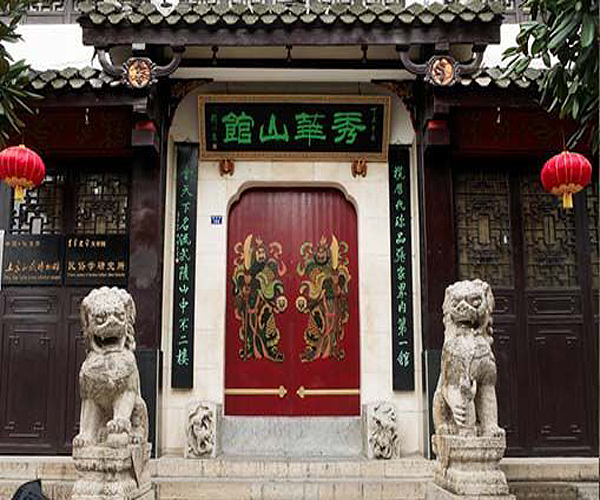
Xiuhuashanguan is the first Tujia people’s museum in China. The long mysterious culture and the rich special national customs are combined harmoniously, they were called as “the miniature of West-Hunan culture” and “the spirit of Tujia nationality”. The collections add up to 15,088 pieces, especially well-known for the Tujia bed carved with flowers and the colorful stone sculpture in Ming dynasty. It is worthy of the name “ Tujia dynamic museum” and welcomed by the tourists from all over the world.
Yongding District
2010-11-23 16:24
View:5356
-
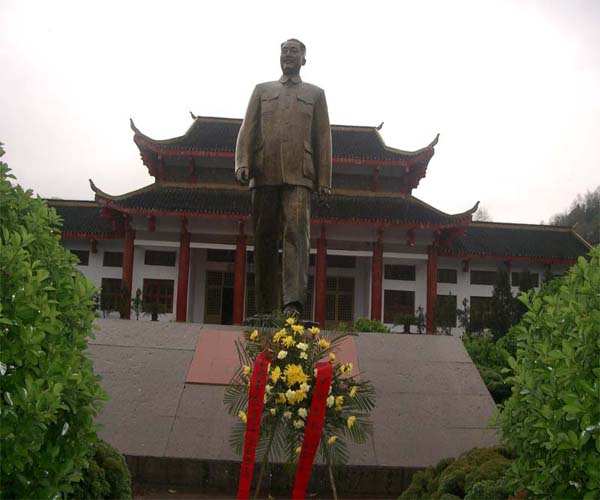
Established in 1996, He Long Memorial Hall is on show with various periods of 337 pictures and 138 cultural relics and documents of the life of He Long, which are divided into five parts: firm ambition of saving the nation and the people, a great proletarian militarist, a distinguished founder of new China’s sport cause, an important leader of the army and the national defense.--- Revolutionary travel.
Sangzhi County
2010-11-23 11:16
View:5288
-
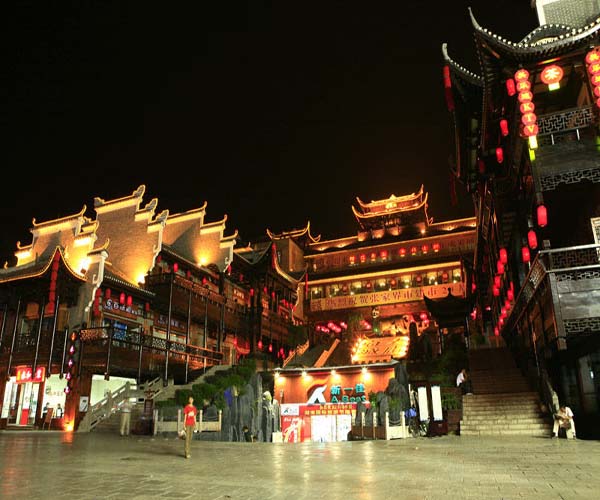
Dayong Town is located in Jiefang Road of Zhangjiajie City, visiting the Dayong Town, you can see both simple and unsophisticated suspended buildings of Tujia Nationality, supernatural and beautiful village of Miao Nationality, wind-rain bridge with romantic and poly posture of Dong Nationality, mystical and august Pan King’s Palace of Yao Nationality, and also quiet, deep and flowery lanes and one screen wall facing the gate of Bai Nationality. Dayong Town is composed of Zhangjiajie Museum area and Zhangjiajie multinational immaterial culture showing hall. The hall mainly consists of village of Tujia Nationality, village of Miao Nationality, village of Dong Nationality, village of Yao Nationality, hall of Bai Nationality. In order to really reproduce the unique living situations of all national minorities, Dayong Town has collected a great deal of precious living articles, and invited some top folk actors to take part in Dayong Town, to perform folk art theaters in Zhangjiajie. The tourists can come to their scene, to learn from the folk-custom activities such as making rice paste, weaving silk tapestry, blanch and dye with wax printing, listening to crying marry, reading woman’s handwritings and etc., and feel the brilliant and multicoloured immaterial cultural heritages of the minorities.
Yongding District
2010-11-23 11:09
View:7028
-
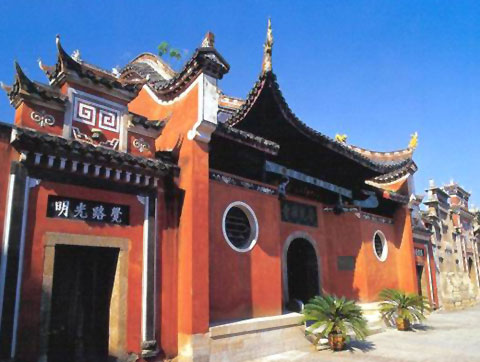
Puguang Temple in downtown Zhangjiajie is a combined sanctuary of Buddhism and Taoism. The buildings represent the architectural styles of the Yuan, Ming and Qing dynasties. There are the Shrine of Sakyamuni Buddha, Martial Art Temple and memorial archways. It is rare in China to have such a religious venue practicing both Buddhism and Taoism and with ancestral shrines, archways and towers.Transport: It can be reached by public buses Nos.1, 3, 6 and 7Tel: (86)744-8292697Admission(for reference): RMB 20 yuan/adultOpening hours: 8:00 a.m.-6:00 p.m.
Yongding District
2010-11-09 17:54
View:4762
-
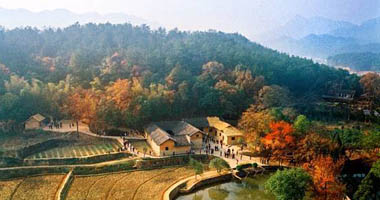
The Former Residence of Chairman Mao is located at Shangwu Ground, Tudi Chong, Shaoshan village, Shaoshan Township. It lies on the south and faces on the north, the building structure is like Chinese character \"凹\". On the east, it belongs to Mao\'s family, on the other side of the house is the neighbor\'s, they shared the central room. On Dec.26, 1893, Mao Zedong was born in the house. We can see Mao\'s family photo, everyday household utensils, all kinds of farm tools, and shoulder pole, bucket, hoe that used by Mao Zedong when he was young. As the hometown of the great man of the generation, now Shaoshan is one of the important tourist zones in Hunan province. The major tourist sites including the Former residence of Chairman Mao, Memorial Hall of Mao Zedong, Water-dripping Cave and Steles Forest of Mao\'s Poems, and so on.Attractions:The former residence of Chairman Mao Shaoshan is a small mountain village about 100km southwest of Changsha, the capital of Hunan province, with some fairly beautiful scenery and a once typically Hunan village atmosphere, Shaoshan has been irreparably changed by history. On the 26th December 1893, a baby was born in a little house in this village, to a relatively wealthy peasant couple. The child was to grow up to become China\'s Great Helmsman, Chairman Mao Zedong, and it was in this region that he spent his childhood and youth, attending school and helping his father with his work.The former residence of Chairman Mao is the most interesting site. Entered through a courtyard, the house is of a sunny yellow, mud brick walls, with a nicely thatched roof, and is found on a wooded hillside, above some lush paddy fields. There are 13 and one half rooms in the Former residence, which include one and half central room, a kitchen, a dining room, three family bedrooms and a guest room. Within the rooms are various personal effects of Mao and his parents, as well as photos from Mao\'s life.This is the central room, used by two families: Mao's family and their neighbor. So we said that there is only one half of the central room belongs to Mao's family. And this is there kitchen, where Chairman Mao often helped his mother doing some housework in his childhood. Go through the kitchen was Chairman Mao's parent's bedroom, there are two photos of Chairman Mao's parents on the inner wall, and it was in this room where Chairman Mao was born. Chairman Mao Memorial HallThe Chairman Mao Memorial Hall commonly known as the Mausoleum of Mao Zedong, or the Mao Mausoleum, is the final resting place of Mao Zedong Chairman of the Politburo of the Communist Party of China from 1943 and the chairman of the Central Committee of the Communist Party of China from 1945 until his death.Although Mao had wished to be cremated, his body was embalmed, and construction of a mausoleum began shortly after his death. This highly popular attraction is located in the middle of Tiananmen Square, in Beijing, the capital of China. On this site had previously stood the Gate of China, the southern (main) gate of the Imperial City during the Ming and Qing dynasties.The remains of the Great Helmsman, as he is sometimes known, are on display for public viewing. People line up for hundreds of feet (dozens of meters) every day to see the former chairman, many paying tribute to him with flowers which can be rented at the entrance on the north side. There is a souvenir shop at the exit on the south side. Comrade Mao Zedong Bronze Statue SquareComrade Mao Zedong Bronze Statue Square was built at Chairman Mao\'s 100th birth anniversary in 1993. It is located in the center of the core scenic area of Shaoshan. It is the main site for domestic and overseas tourists to commemorate Comrade Mao Zedong, the venue for a variety of large-scale events, and the distribution center for visitors who tour Shaoshan. Comrade Mao Zedong Bronze Statue Square was reconstructed and extended at Chairman Mao\'s 115th birth anniversary in 2008. It is \"Number One Project\" in the Shaoshan major construction projects. Approved by the Central, \"Small Displacement, Small Shift\" program was used to renovate and expand Comrade Mao Zedong Bronze Statue Square based on the original one. After the reconstruction, the total area of the square is 100,000 square meters now and the height of Comrade Mao Zedong bronze statue is 10.1 meters tall including the foundation. Backed by Shaofeng and facing the former residence, People in this magnificent and solemn atmosphere can have a better understanding of the extraordinary spirit of the great man Mao.The Dripping Water CaveThe Dripping Water Cave, about 3 km northwest of the village, is a very popular destination, possibly because of the fact that Mao allegedly spent 11 days here in the early days of the Cultural Revolution Years (1966-76), contemplating the unknown.Shaoshan Steles Forest of Mao’s PoemsMao Zedong\'s Poetry Forest of Stone Tablets is located half way up the mountain of Shaofeng and about 3 kilometers away from Mao Zedong\'s Former Residence. It was formally opened in 1993, with a total area of nearly 20,000 square meters. The whole garden is divided into five parts according to Mao\'s revolutionary career and four periods by the chronological order.The first part: Mao Zedong\'s poetry written in his youth.The second part: Mao Zedong\'s poetry written during the time of Great Revolution and the second Revolutionary War. The third part: Mao Zedong\'s poetry written in the time of Long March of the Red Army, Anti-Japanese War, and the War of Liberation.The fourth part: Mao Zedong\'s poetry written after the establishment of new China.On hillside stood steles engraved with Mao’s fifty poems. Among them 28 is Mao’s original handwriting. Due to the poetic sentiment and picturesque layout, it is appraised as one of Hunan’s best scenic spots. The Peak of Mount Shaoshan Mount Shaoshan has an abundance of green and old trees. There are eight scenic spots and five marvelous spectacles. Tourists can climb to Shaoshan old temple on mountaintop while enjoying birds singing and pine trees whistling and the beautiful sceneries. Cableway is also available.Travel tips:This site is on the outskirts of Shaoshan (approximately 104 km outside of Changsha) and is easily reached by bus.Huaminglou, Liu Shaoqi\'s former residenceHuaminglou is in a beautiful small town of South Changjiang. It is located o?n the bank of Jinjiang River, northeast border of Wangcheng County, in the southeast of Ningxiang County boundary, Hunan Province. Its neighboring is Xiangtan and Xiangxiang city in southwest and is 30 kilometers east from provincial capital Changsha. The distance from Mao Zedong\'s hometown, Shaoshan, is 37 kilometers o?n the south and is 30 kilometers west from the county. Huaminglou scenic area occupies more than 670,000 square meters with the total floor space of 35,000 square meters. The main scenic spots are Liu Shaoqi\'s Former Residence, Memorial Hall, Bronze Statue Square, Exhibition Hall, Huaming Tower, Accomplishment Pavilion, Airplane Liu Shaoqi Had Taken, Ancestral Graves of Liu Shaoqi, Wang Guangmei\'s Tomb, Landscape Diagram of the Universe, etc. It has gained the honor of \"the first batch national patriotic education bases,\" \" the first batch national AAAA level traveling scenic spots,\" \"one of Ten Chinese classics red scenic spots,\" so it is a revolutionary commemorating and traveling spot with national influence.What to visitHuaminglou is famous for it\'s the hometown of Liu Shaoqi - one of the great leaders in Chinese revolution, His former residence is surrounded by lots of trees, and there are more than 30 wood rooms in the courtyard. Apart from the living room, there is also reading room for children to study.Memorial Museum 500 meters from Liu Shaoqi\'s former residence, there is a Memorial Museum in honor of him, in the museum there are more than 800 cultural relics and materials, including some of Liu Shaoqi\'s books and daily things.Liu Shaoqi\'s Bronze Statue SquareLiu Shaoqi\'s Bronze Statue Square covers more than 8,000 square meters. The bronze statue was donated by the Chinese National General Labor Union, and sculptured carefully by famous sculptor Liu Kaiqu and Cheng Yunxian. The statue is 7.1 meters high (including the base) which implies two meanings. July 1st is the birthday of Communist Party of China, symbolizing Liu Shaoqi\'s outstanding contribution to Communist Party.Meanwhile, Liu Shaoqi died at the age of 71, implicating his glorious and great life. The bronze statue was completed on November 24th, 1988. President Yang Shangkun unveiled it personally. In 1998, General Secretary of CPC and President Jiang Zeming inscribed for the bronze statue. Huaming ParkHuaming Park occupies more than 130000 square meters. It\'s a park carries Chinese traditional virtues as the culture theme with the sites of Huaming Tower, Accomplishment Pavilion, Airplane Liu Shaoqi Had taken, Wande Tripod Cauldron, A-leaf Lake, etc. It opened in 2003. Huaming TowerHuaming Tower is a five storey tower with the height of one hundred feet. It is ancient dignified, grand and magnificent with jujube color corridors, carved pillars and drawings. The tower is decorated by the background of plum, orchid, bamboo, chrysanthemum and lotus, which implies the lofty thought of Liu Shaoqi for persisting in the truth and never changing his aspiration.Airplane Liu Shaoqi Had TakenDoyle -18-240 airplane is a turbine spiral medium range airliner imported from former Soviet Union in 1959. The fuselage is 36.9 meters. It has wingspan of 37.4 meters and weights 32 tons, which was the specified airplane for leaders of Communist Party and country. Liu Shaoqi, Zhou Enlai, Peng Zhen, Chen Yi all had taken this plane. It has accompanied Liu Shaoqi to participate in many important activities about foreign affairs. In 1963, Liu Shaoqi visited Indonesia, Burma, Cambodia and Vietnam by this plane. Moreover, Liu Shaoqi accompanied Jin Richeng to meet Mao Zedong from Beijing to Wuhan by the plane on the eve of discussion war between China and Soviet Union.In December 2000, the National Bureau of Cultural Heritage organized some experts on revolutionary cultural heritage to appraise it. A document named was written to collect the plane Liu Shaoqi had taken. This specified plane is the true one after appraised by captain and mechanic who drove it before, so it has high historical value. The museum is authorized to preserve it as a precious cultural heritage. On September 2nd, 2003, the airplane successfully settled in Huaming Tower. On November 24th in the same year, it was opened to public formally. The plane is preserved completely. The cabin was separated into the first-class cabin, ordinary cabin, resting cabin, goods preservation cabin and toilets except for cockpit, the seats and military beds in cabins are the originals.Airplane Liu Shaoqi Had TakenThe name of Accomplishment Pavilion comes from Liu Shaoqi\'s work Accomplishment of Members of Communist Party. Accomplishment Pavilion is composed of main pavilion, two courtyards and a small assembling square. There are original handwriting of outline on Accomplishment of Members of Communist Party, discussion accomplishment by celebrities in previous dynasties, the appraisal of three generations of leaders on Accomplishment of Members of Communist Party, and contemporary calligraphy and painting work of celebrities.Travel Tips:When to goChangsha falls within the subtropical monsoon climate with distinct seasons and changing temperature. The annual temperature is 17.2℃. The weather of spring in Changsha is changeable; you need to wear thick clothes. The autumn begins from the middle of August. The weather is fine and the sky is clear. To sum up, September and October in autumn is the best time for traveling.Traffic There are coaches from Changsha to Ningxiang, and there are buses to huaminglou from Changsha, Ningxiang, Shaoshan. You can go there by bus.It is about 50 kilometers apart from Changsha and the bus fare is around 20RMB. The Huaminglou town is the hometown of Liu Shaoqi, one of the main and respected leaders in China. All of the Huaminglou scenic area takes up 470,000 square meters and the admission fee is 30RMB.the Former Residence of Chairman Mao is on the outskirts of Shaoshan (approximately 104 km outside of Changsha) and is easily reached by bus.You can first vist Liu Shaoqi\'s former residence and then take the bus from there to the Former Residence of Chairman Mao. It will take you 20 yuan and 30 mininutes.
Changsha & Zhuzhou & Xiangtan
2010-10-06 19:14
View:9821
-
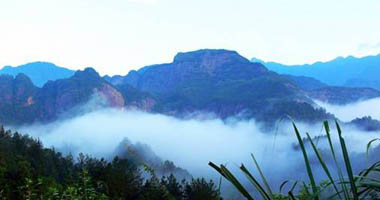
Huping MountianHuping Mountain(kettle-shaped Mountain), Roof of Hunan, located in Shimen County, is the state-listed nature reserve as well as one of the 200 global key ecological areas. It is also famous as a natural labyrinth of Global Fantastic Circle and a species gene bank in Central China. Huping Mountain National Level Protection Area covers an area of 45000 hectares. The whole natural protection area covers an area of 665.7 square kilometers.350 million years ago. Huping Mountain with perilous peaks and deep valleys embodies 266 peaks at an altitude of over 1000 meters and a major lofty peak, 2098.7 meters above sea level, which is the highest peak of Hunan. It boasts the deepest, narrowest and grandest gorge in Mid-east area. The gorge, over 200 kilometers in length, with a relative height of peaks and valleys varying from 800 meters to 1000 meters, exposes a great deal of typical annual sections, including the largest Cambrian Stratum section in the world. Huping Mountain has plenty of waterfalls, water-eroded caves, streams in the crisscross network. The largest Huping Waterfall is 400 meters in height and 20 meters in width. Once Libai(a great poet of Tang Dynasty) traveled here and made a comment that waterfalls splash in Huping, peach flower falls down the mouth of cave. Rafting in Huping Mountain, which has more than 80 dangerous shoals up to 22 kilometers in length and a waterdrop in level of over 90 meters, is characterized by \"the whirling rapid flow\".The area from Nishi Town to Dingping Mountain with an altitude of 1870 meters, is the best place for eco-tour. As not affected by the fourth glacier, Huping Mountain remains well entironment and a mass of rare plants. It is regarded as \"the gene pool of central China\" by experts home and abroad. In Hupingshan there are 172 kinds of terrestrial vertebrates , 53 of which are rare and endangered animals Such as the South China tiger, leopard, black bear, monkey, serow, golden eagle, red-bellied Tragopan, short mouth swiftlets, giant salamander, etc. So it is also confirmed to be one of the 200 global key eco-areas by International Nature Fund and two other international organizations.AttractionsTo watch the seasons change in a place with every natural beauty - mountain peaks, rivers, flowers and forests, Huping Mountain in Central China\'s Hunan Province is your best choice. The mountain is the highest peak in the province at 2,098-metres. But climbing to the very top of the mountain is beyond most visitors and is usually left to the more skilled and fit climbers. However, they are rewarded for their efforts by the panoramic views available from the mountain peak and the fact that they have to share the place with fewer tourists. Flying waterfalls 1or less adventurous visitors, the mountain\'s biggest waterfall is the next attraction. It has been praised for its beauty and power for centuries. The renowned poet Li Bai of the Tang Dynasty (AD 618-907) wrote a famous poem about it. But when visitors walk into the Bizigou,(鼻子沟) they will be surprised to find many other waterfalls dropping gracefully into the narrow valley. In one section, there are dozens of waterfalls of different sizes falling in plumes of white foaming thunder onto huge boulders on the floor of the valley. Most of the more spectacular waterfalls have their own names such as Beauty Waterfall, where several beauties were said to have been seen bathing in ancient times. Another is named Tongziniao(童子尿) (Boy\'s wee-wee) Waterfall because it looks like a little boy doing weewee from the mountain. Bathed in the moisture provided by the waterfalls, the trees and grasses are more green and fresh than visitors are used to. Steep valleysTo view more beautiful waterfalls, travellers must pass through some narrower valleys. Dozens of rivers and waterfalls that have been flowing for hundreds of thousands of years have carved out these deep and sheer valleys. High trees shelter the valleys and even on sunny days, the light in some of the valleys is a little dim. In some valleys with their steep sides more than 800 metres high, it can be a little frightening, as if the waterfall roaring down could swallow its visitors. Care should be taken when climbing in some valleys because they can narrow quite sharply and it can be difficult to pass. Valleys such as Jinjiahe Valley, Xianglianhe Valley and Huanglianhe Valley with different but beautiful views are all worth visiting. Some peaks in the surrounding mountains look strange. After many thousands of years of wind and rain, some strange-looking stone bridges, caves and cracks have been created by Mother Nature. Mount in sunsetThe region is also famous for its colourful sunsets. More than 6,500 kinds of flora and fauna live and grow around Huping Mountain. Wenfeng Peak stands lonely against the sky to the north of Huping Mountain. It looks like a bamboo shoot from the southwest. But if you stand to the northwest of the peak, it looks like a pile of donkey manure and its original name was \"Donkey Shit Peak\". The poet Li Bai, mentioned above, thought the name was not elegant so he changed it to Wenfeng Peak. Farmers have tamed the wild mountain with terrace fields and it now has layers of green growth in the spring and summer, while in the autumn, it looks golden. Name: Huping Mountian City: Changde City Address: Shimen County of Changde City, Hunan Province Hours:7:00-18:00 Tel: (86) 0736-5334190 Address: Shimen County of Changde City Admission: CNY 50 Transportation: There are long-distance buses to Shimen County in Changsha Western Station, which starts at 8:50,9:20, 10:30, 12:50 ,14:20,15:00 15:30,20:00 or 22:20. There are trains going to Shimen county at the Changsha Railway Station.The detailed information is listed in the table below. In Shimen Western Station, the Buses driving to Jiangping and Nanping can bring you to Huping Mountain.
Changde & Yueyang & Hengyang
2010-10-05 20:39
View:6233
-
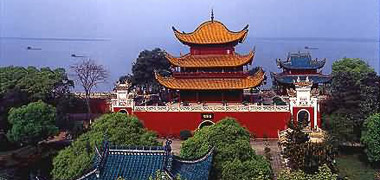
Landscape spots: Baling landscape (including Yueyang Tower, Junshan Island, Memorial Temple of Qu Yuan and Zhang Guying Folk Custom Village) For More Yueyang,formerly knowns as Baling or Yuezhou, is a historic and cultural city with a long history of more than 2,500 years. Located at the northeast of Hunan Province, neighboring Jiangxi Province in the east and Hubei Province in the north, Yueyang was a hinterland of military importance during the past dynasties. Nowadays, renowned for so many historic interests, Yueyang is ranked as one of the China\\\'s Top Tourism Destination Cities.Yueyang\\\'s real charm rests with human cultural relics as well as the natural landscape.Yueyang City\\\'s attractions includies Yueyang Tower, Junshan Isle, Memorial Temple of Qu Yuan and Zhang Guying Folk Custom Village. AttractionsYueyang Tower(Yueyang Lou) Located on the west city wall, the Yueyang Tower is one of three famous towers in South China, the other two being the Yellow Crane Tower in Wuchang and the Prince Teng Pavillion in Nanching. The predecessor of Yueyang Tower was a structure built during the Three Kingdoms period (220 -280 AD) for reviewing military parades. In the fifth year of Emperor Qingli\\\'s reign of the Song Dynasty (716), it was rebuilt, and famous Song Dynasty essay writer Fan Zhongyan(范仲淹) wrote his famous essay \\\"Notes on Yueyang Tower\\\", which was considered matchless in literary beauty and profound thought. Yueyang Tower stands close to Dongting Lake, facing Junshan Isle with the city behind. The main tower, 19 meters high, is a three-story structure supported by four pillars and made of pure wood and upturned eaves. Especially noteworthy is the tower top which resembles a helmet used by warriors in ancient times, a real rarity in the history of ancient Chinese architecture. The structure is a unique combination of artistic tastes, mechanics, architecture, and craftsmanship. The Tower affords a spectacular view of Dongting Lake. Name:Yueyang Yueyang Tower(Yueyang Lou)City:YueyangAddress: on the west city wallAdmission:CNY 46 for adults & CNY 25 for kidsHours:8:00-16:00 Tel:0086-730-8311676 Junshan Isle Junshan Isle is the most famous island in Dongting Lake. It consists of 72 hilllocks, covering an area of 0.96 km2 and rising only 55 meters above sea level. There are many scenic spots and places of historic interest, and many touching fairy tales are told about the island. As the old saying goes, \\\"the water in the Dongting Lake and Junshan in it are viewed as green from the distance. The island resembles a green snail in a silvery plate.\\\" This line was used by ancient people to describe the beautiful scenery of Junshan. The islet, small enough, used to be crowned with as many as 36 pavilions and 48 temples, which were mostly in ruins at the time of liberation. Since the park was established in 1979, many historic sites have been renovated.The Tomb of TWO Concubines is enveloped in a moving story. Legend has it that the two beauties buried here were daughters of Emperor Yao, a mighty trial leader at the end of the primitive society. When Shun succeeded their father, they were married to him as imperial concubines. Unfortunately, Shun died a sudden death when he went the rounds in present-day Ningyuan County of Hunan. The two concubines heard of his death and were heart-broken. At last, they died of grif. To commemorate them, people built the tomb in the east of islet and renovated it dozens of times. Name:Yueyang Junshan Isle (Junshan Dao)City:Junshan county in Yueyang cityAdmission: CNY 60Transport: No.15 sightseeing bus goes from Yueyang Railway Station to the Junshan Scenic Area for 40 minutes & 5 yuanTel: (86)730-8159311Memorial Temple of Qu Yuan Memorial Temple of Qu Yuan is a tourist attraction especially sacred to literary men .It was built on a hill by the Miluo River in memory of Qu Yuan(340BC-278BC), a great patriotic poet and upright stateman of the State of Chu during the Warring States Period(475BC-221BC) .He was exiled late in his life to present-day Miluo. Though in disfavor, he was especially concerned about the fate of his mother-land and had his patriotic feelings crystallized in his collections of poems. At the news of the subjugation of his mother-land by the state of Qin, he was plunged into grief and despair, and, clasping a big stone in his arms, he drowned himself in the Miluo River.The temple is on the Yusishan Mountain in Miluo of Yueyang. Covering an area of 7.8 acres on top of a woody hill by the Miluo River, dates back to 1756. It was surrounded by a grey brick wall and shadowed by old phoenix trees. The front gate is guarded by eight stone divine lions, and the archway is decorated with sixteen painting the life of Qu Yuan here. The main hall is a large structure of wood and brick with a single- eaved roof that covered with yellow glazed tiles. Poetry and proses grieving the death of Qu Yuan are inscribed on the four stone walls. In the front hall is a huge wooden board inscribed with The Biography of Qu Yuan by Sima Qian. Name: Memorial Temple of Qu Yuan(Quzi Ci)City:Miluo in Yueyang cityAdmission: CNY 15Transport: From Yueyang city by train to the Miluo railway station or by coach direct to Miluo city then take a bus to reach Memorial Temple of QuYuan directly. Zhang Guying Folk Custom Village Zhang Guying Folk Custom Village is located in Yueyang. This is a group of building connected by a big family. With the expanding of the family, the whole building was expanded too. The group building is still in good conditions despite being through so many years. Its sewing system is very advanced which gains the interest from many architects. Name:Yueyang Zhang Guying Folk Custom Village (Zhang Guying Cun)City:YueyangAddress: Yueyang county in Yueyang cityAdmission: CNY60Hours: 8:00-18:00Tel:0086-730-8311676Transport:Every day there is a bus to Zhang Guying Village in eastern bus station of Changsha, its departure time is at 1:50 pm, full fare 20 yuan.Transportation from Changsha to YueyangIn Yueyang, tourists need no worries in regard to transportation. Tourists can reach Changsha Huanghua International Airport which is only 130 kilometers (80.78 miles) from Yueyang and takes about one hour\\\'s ride on the high-speed motorway to Yueyang. The high-speed motorway system for road transportation has been long established in Yueyang and radiates in all directions. Transportation by water is also convenient in Yueyang because Yueyang is the only port in Hunan Province which is beside the Yangtze River.
Changde & Yueyang & Hengyang
2010-10-05 20:32
View:5325
-
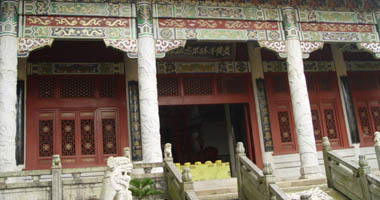
The Chinese people are proud of being descendants of Emperor Yan and Emperor Huang, who respectively ruled the Yangtse River valley and Yellow River about 5,000 years ago. They both made great contributions to their primitive tribes and are looked on as the revered ancestors of the whole nation.According to legend, Emperor Yan \"Invented\"spade-shaped plough, taught his subjects how to do farm work, tasted various herbs, made medicines, wove hempen cloth and set up markets.\"Late in his life, he continued to serve his people by treating their diseases and, unfortunately, died of tasting poisonous herbs in Ling County. Admiring his merits and virtues, his posterity built the Ancestral Temple to Emperor Yan at his burial mound in 967. Since then, in important ceremonials, sovereigns of every later dynasty would always tell envoys to visit the temple and offer sacrifices. Ruined several times in wars, it was rebuilt in the Qing dynasty(1616-1911). Yet, in 1954, it was burnt down. In October, 1985, the provincial government approriated a large sum of money and ordered the construction of the Mausoleum of Emperor Yan at the former site in Ling County. Now it has been a sacred place where the Chinese people pay homage to their ancestor.The front gate is called the Meridian Gate since our ancestor enjoys supremacy even unchallenged by sovereigns. It is flanked by partitioned rooms that house dozens of steles inscribed with funeral orations of varous dynastied . Beyond the gate, the vermillion steps lead to the Salute Pavillion, where worshipers are supposed to stop and give a salute before entering the main hall. Behind the pavillion unfolds three marble ramps carved in relief with patterns of invertwining clouds and dragons. They are fixed between six flights of marble steps that climb up the three-tiered terrace. High on the terrace stands the main hall, a finely decorated building with a hipped and gabled roof of double eaves. It houses a golden statue of Emperor Yan siting behind a basketful of crops, with a bunch of rice ears in the left hand and a medicinal herg in the right hand. Behind the hall is a pavillion, in which the grave stone is erected; and further on, the resting place of our revered ancestor lies in the rear of the courtyard. These major buildings, distributed one after another along the central axis, are symmet-rically flanked by minor buildings, such as the Sage-Worshiping Temple the Loft Virtues Archway, the Animal- Sacrificing Pavilion and the Harvest-Singing Terrace.Surrounded by towering old trees, the mausoleum seems all the more stately and splendid, with the golden roof s flashing brilliantly in the sun and the purple walls occasionally from behind the lush trees. The Emperor Yan\'s Mausoleum CeremonyChinese people are proud of being descendants of Emperor Yan and Emperor Huang, who, respectively, ruled the Yangtse and Yellow River vallies, about 5,000 years ago. As the legend goes, Emperor Yan went south to find herbs to treat his people. Unfortunately he ate some poisonous herbs, and died. In 967, in admiration of his merits and virtues, the Ancestral Temple was built, for him, at his mausoleum, which is at the foot of a mountain in Zhuzhou City, Hunan Province.According to historical records, people have performed sacrificial rituals in honor of Yan, since the Han Dynasty (206BC-AD220). There are a variety of activities in the ceremony, including offering objects or animals, playing music, and dragon dance performances, among others.The memorial ceremony has two types; the official and the folk, both of which have been preserved from ancient times. According to historical records, the grand ceremony was held 15 times during the Ming Dynasty (1368-1644), and 38 times during the Qing Dynasty (1644-1911).During its long history, the ceremony performed at Yan\'s mausoleum has become a culture with its own music, dance and literature. To commemorate Yan\'s discovery and use of fire, nine dragons are set alight, on stage. These then ignite the top firestone with the flames spouting from their mouths. The performance symbolizes that the Chinese people are descendants of dragons. In the square of the divine dragon hall, yellow, cyan,black, white, and red dragons perform according to the five different orientations, an embodiment China\'s rich traditional culture. Since China\'s reform and opening up in 1979, emperor Yan\'s mausoleum has become a prominent cultural artifact, and taking part in the rituals has become an important way of expressing patriotic sentiment, for many Chinese. In recent years, more than 100,000 overseas Chinese have come back to take part in the annual event. Attractions:Although we can\'t work out when Emperor Yan Mound was first built, according the records of history books, it must have been built before the Five Dynasty. In 967 A.D., Emperor Taizong of Song Dynasty assigned people to build a temple in front of Emperor Yan\'s Mound and Emperor Kangxi and Emperor Daoguang of Qing Dynasty also assigned officials to stand gravestones here. Emperor Yan is o?ne of the ancestors of Chinese people, he and Emperor Huang are called Yanhuang.Emperor Yan\'s Mound tourist zone includes human sight as Emperor Yan\'s Mound, Emperor Yan Temple, Fengshen Temple, Congde Lane, Huzhenguan Temple, Luyuan Kiosk and Holy Fire Dais, and natural sight such as Luyuan Cave, Dragon Head Stone, Dragon Claw Stone and Flower Washing Pool, all of them are very attractive.Emperor Yan\'s Mausoleum Scenic AreaSituated on Luyuan Slope west of Yanling County, it is a national AAAA scenic area. Among the tourist attractions in the scenic area, the most important one is Emperor Yan\'s Mausoleum which is a State Preservation Unit of Key Historical Relics and a national AAAA tourist zone. The mausoleum was built in 967 AD during the North Song Dynasty to commemorate Emperor Yan, one of the earliest ancestors of the Chinese people. In 2005 it was listed in the Top Ten Cultural Relics of Hunan Province. Other attractions include Emperor Yan Temple,Chongde Memorial Archway, Luyuan Pavilion, Saint Fire Terrace and Luyuan Cave. Over the past hundreds of years, sacrificial ceremonies have been held in front of Emperor Yan\'s Mausoleum. Now it is a sacred place for all the descendants of Emperor Yan and Huang in the world to seek their roots and pay homage to their earliest ancestors.Emperor Yan’s Mound is 6 m high and the diameter of its bottom is 27 m long. In front of the mound stands a gravestone set up by Emperor Daoguang in Qing Dynasty, writing the epigraph “Emperor Yan Shennongshi’s Mound”. In 1986, when the repair construction was finished, president Hu Yaobang also wrote a epigraph “Emperor Yan Shennongshi’s Mound”, which was carved into the white marble gravestone standing in the center of gravestone kiosk in front of the mound. All the Mound zone is surrounded by high mountains and Mishui River flows under the mountains, so the environment here is very quiet and peaceful.Travel tips:Zhuzhou enjoys humid monsoon climate in subtropical zone. The four seasons are distinct; the rain and heat is abundant with 286 days of frost-free period. The annual average temperature falls between 16℃ and 18℃. The four seasons are suitable for traveling, especially spring and autumn.If you go to Emperor Yan\'s Mound Tourist Zone to sacrifice Chinese people\'s ancestor, Shenlongshi, think of his great deed in tasting various herbs and recall his benefaction, you will have a feeling of thankfulness and bring a pure deep love to our people and nation.TrafficThe mausoleum of Emperor Yandi is in Luyuan Slope, 19 kilometers west of Yanling County, Hunan Province.You can take a bus to Zhuzhou city from Changsha.Then Take scheduled bus in Zhuzhou City to Yanling County. Then take a bus to Emperor Yan\'s Mausoleum and get off at Yandi Emperor Mausoleum arch, take the local bus, the fare is $3 or 4, the fare of taxi is $20-30.Admission (for reference): RMB 45yuan /adultTel: (86)731-26100857Yandi Mausoleum fee and opening hourTicket : 15 yuanOpening hours: 08:00-17:30Tips1.If you go to Emperor Yan\'s Mound Tourist Zone to sacrifice Chinese people\'s ancestor, please keep silent and dignified.2.please respect Chinese cultural monument, do not scrawl randomly and touch them with your hands.
Changsha & Zhuzhou & Xiangtan
2010-10-05 19:40
View:7245












